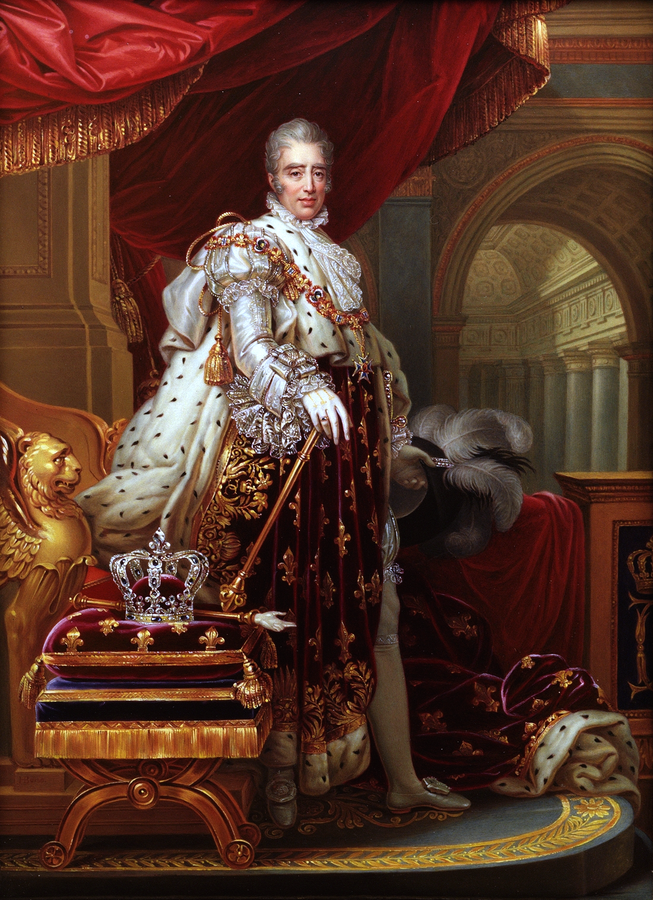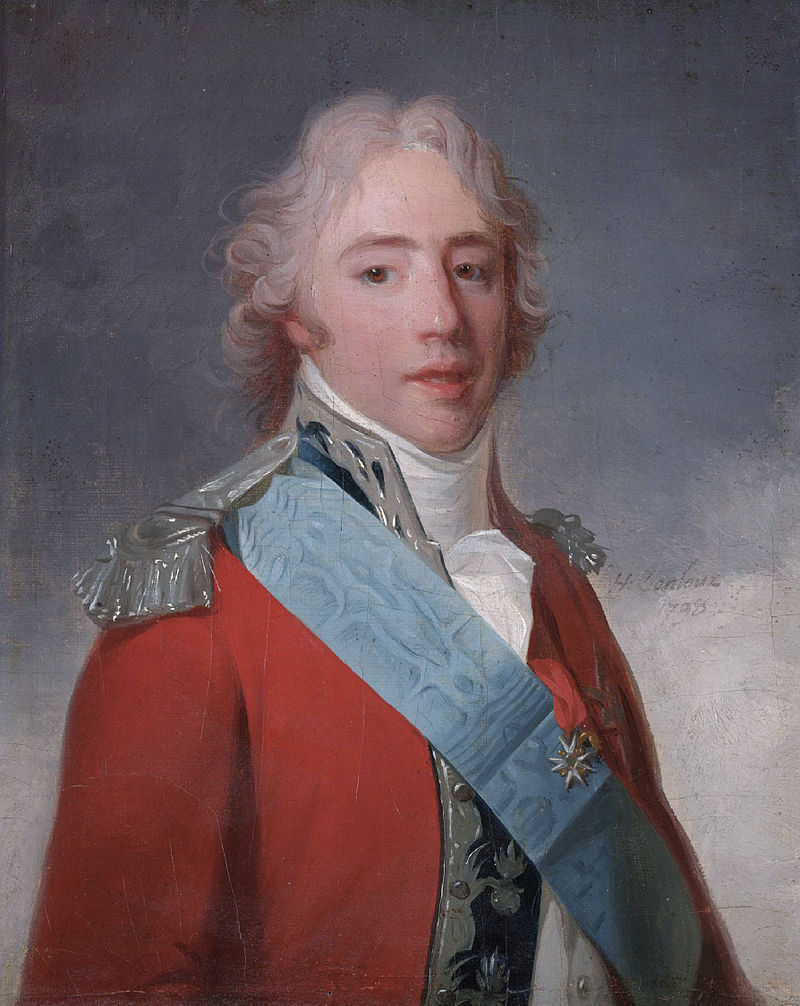by Scott Mehl © Unofficial Royalty 2016

King Charles X of France – source: Wikipedia
King Charles X was the last King of France from the House of Bourbon. He was born at the Palace of Versailles in France on October 9, 1757. His grandfather King Louis XV of France created him Count of Artois at birth. Charles was the sixth child and third son of Louis, Dauphin of France, and Princess Maria Josepha of Saxony. He had seven siblings:
- Marie Zéphyrine (1750 – 1755), died in childhood
- Louis Joseph, Duke of Burgundy (1751 – 1761), died in childhood from tuberculosis
- Xavier of France, Duke of Aquitaine (1753 – 1754), died in infancy
- Louis XVI, King of France (1754 – 1793), married Archduchess Maria Antonia of Austria and had four children, executed during the French Revolution
- Louis XVIII, King of France (1755 – 1824), married Marie Joséphine of Savoy, no children
- Marie Clotilde (1759 – 1802), married Carlo Emanuele IV, King of Sardinia, no children
- Élisabeth (1764 – 1794), unmarried, executed during the French Revolution
He was given the names Charles Philippe at his christening in the Chapel Royal at the Palace of Versailles. His godparents were King Carlos III of Spain and his aunt Sophie-Philippine of France.

Engraving of the marriage of Charles and Maria Teresa of Savoy, 1773. source: Wikipedia
On November 16, 1773, at the age of 16, Charles married Princess Maria Teresa of Savoy at the Chapel Royal at the Palace of Versailles. She was the daughter of King Vittorio Amadeo III of Sardinia and Infanta Maria Antonia of Spain. Maria Teresa’s elder sister was the wife of Charles’ elder brother Louis Stanislas (later King Louis XVIII). The couple had four children:
- Louis Antoine, Duke of Angoulême (1775 – 1834) – married Marie Thérèse of France, daughter of King Louis XVI of France and Marie Antoinette, no issue
- Sophie (1776 – 1783) – died in childhood
- Charles Ferdinand, Duke of Berry (1778) – married Maria Carolina of Bourbon-Two Sicilies, had issue
- Marie Thérèse (born and died 1783) – died in infancy
Following the Storming of the Bastille in 1789, Charles and his family took refuge in Savoy and then traveled through Europe. After the French monarchy was abolished in September 1792, Charles’s brother King Louis XVI and his family were imprisoned and executed the following year. Charles escaped to the United Kingdom, where he was warmly welcomed by King George III who gave him a large allowance and provided him with apartments at the Palace of Holyroodhouse in Edinburgh, Scotland. Charles also had a residence in Mayfair, London, where he spent much of his time with his longtime mistress, Louise d’Esparbès de Lussan. His elder brother, now the titular King Louis XVIII, eventually came to the United Kingdom in 1807.

Charles, Comte d’Artois, c1798, painted by Henri-Pierre Danloux. source: Wikipedia
When Napoleon was overthrown in 1814 and Louis XVIII formally made King of France, Charles served as Lieutenant-General of the Kingdom until the new King could return to France. While supporting his brother, Charles was also very vocal in his disagreement with many of the King’s liberal policies. On September 16, 1824, King Louis XVIII died, and Charles succeeded to the French throne as King Charles X. He would be very unpopular with the French people, and would not remain on the throne for long. While his brother had been much more liberal, and accepting of the changes needed to retain the monarchy in an evolving France, Charles longed for a return to absolute rule. He often instructed his prime minister to change or remove laws that he felt were too liberal.
King Charles X’s actions led to the July Revolution of 1830 and his abdication. After ordering General Elections to be held, Charles was not happy with the results, and on July 6, 1830, he suspended the constitution. Several weeks later, he issued four ordinances, censoring the press, dissolving the newly elected chamber, changing the electoral system, and calling for new elections in September. When these ordinances were published, there were quick calls for revolution. When rioting began, a team of ministers pleaded with the King to revoke the mandates but the King refused any compromise. By the end of the night, the members of the Chamber of Deputies had decided that the King must go and that they should pass the throne to the Duke of Orléans who would become Louis-Philippe, King of the French.
On July 31, 1830, King Charles X left the Château de Saint-Cloud, intending to take refuge at Versailles. However, he was met by revolutionary troops and instead went to the Grand Trianon and the Château de Rambouillet the following day. Louis-Philippe, the Duke of Orléans declared himself Lieutenant-General.
On August 2, 1830, King Charles X abdicated the French throne, skipping over his son and naming his grandson Henri, Duke of Bordeaux as his successor. Louis-Philippe refused to accept the terms of the abdication and instead had himself proclaimed King of the French. With an approaching mob, Charles and his family left Rambouillet and sailed to the United Kingdom. They lived briefly at Lulworth Castle in Dorset before returning to the Palace of Holyroodhouse. In the winter of 1832, the family moved to Prague at the invitation of Emperor Franz I of Austria, taking up residence at the Prague Castle. They remained there until the Emperor’s death in 1835 when they purchased Kirchberg Castle.
In the fall of 1835, Charles traveled to Austria’s Mediterranean coast to enjoy the warmer weather. While in Görz, Austria (now Gorizia, Italy), he contracted cholera. The former King Charles X of France died at the Strassoldo Palace in Görz on November 6, 1836. He was buried in the crypt of the Kostanjevica Monastery in what is now Pristava, Slovenia

Tombs of Charles X and his son Louis at the Kostanjevica Monastery; Credit – Wikipedia
This article is the intellectual property of Unofficial Royalty and is NOT TO BE COPIED, EDITED, OR POSTED IN ANY FORM ON ANOTHER WEBSITE under any circumstances. It is permissible to use a link that directs to Unofficial Royalty.
France Resources at Unofficial Royalty
